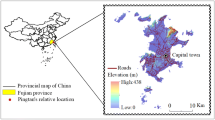Abstract
Based on SPOT-5 images, 1:1 million topographic maps, the maps of the returning farmland to forest project and the Chongqing forest project, social and economic statistics, etc., this paper identifies the features and factors influencing farmland marginalization. The results showed: (1) During 2002–2012, the rate of farmland marginalization was 16.18%, which was mainly found in the high areas of northern Qiyao mountains and the medium-altitude areas of southern Qiyao mountains. And this farmland marginalization will increase, associated with non-agriculturalization of rural labourers and aging of the remaining labourers. (2) Elevation, distance radius from villages and road connections had a great influence on farmland marginalization. Farmland marginalization rates showed an increasing trend with the increase of elevation, and 60.88% of the total farmland marginalization area is found at an altitude greater than 1000 m above sea level. The marginalization trend also increases with slope and distance from the distribution network. (3) Farmland area per labourer and the average age of farm labourers were major factors driving farmland marginalization. Farmland transfer and small agricultural machinery sets affect farmland marginalization with respect to management and productivity efficiency. (4) Farmland with “comparative-disadvantage-dominated marginalization” accounted for 55.32% of the total farmland marginalization area, followed by “location-dominated marginalization” (33.80%). (5) According to the specifics of each real situation, different policies are suggested to mitigate the marginalization. A “continuous marginalization” policy will encourage the return of farmland to forest in “terrain-dominated marginalization”. An “anti-marginalization” policy is suggested to create new rural accommodation and improve the rural road system to counteract “terrain-dominated marginalization”. And another “anti-marginalization” policy is planned to improve management and micro-mechanization for “comparative-disadvantage-dominated marginalization”. A new idea was developed to integrate high resolution remote sensing and statistical data with survey information to identify land marginalization and its driving forces in mountainous areas.
Similar content being viewed by others
References
Aubry C, Ramamonjisoa J, Dabat M H et al., 2012. Urban agriculture and land use in cities: An approach with the multi-functionality and sustainability concepts in the case of Antananarivo (Madagascar). Land Use Policy, 29(2): 429–439.
Baumann M, Kuemmerle T, Elbakidze M et al., 2011. Patterns and drivers of post-socialist farmland abandonment in Western Ukraine. Land Use Policy, 28(3): 552–562.
Ding Guangping, Liu Chengwu, Huang Limin, 2009. A theoretical analysis and empirical research of marginalization of agricultural land in hilly-mountainous area under farmer-benefiting policy: A case study of Tongcheng County in Hubei Province. Geographical Research, 28(1): 109–117. (in Chinese)
Giles J, 2006. Is life more risky in the open? Household risk-coping and the opening of China’s labor markets. Journal of Development Economics, 81: 25–60.
Groom B, Grosjean P, Kontoleon A et al., 2010. Relaxing rural constraints: A ‘win-win’ policy for poverty and environment in China? Oxford Economic Papers, 62: 132–156.
Kang S, Post W, Wang D et al., 2013. Hierarchical marginal land assessment for land use planning. Land Use Policy, 30(1): 106–113.
Li Xiubin, Zhao Yuluan, 2011. Forest transition, agricultural land marginalization and ecological restoration. China Population, Resources and Environment, 21(10): 91–95. (in Chinese)
Liu Chengwu, Li Xiubin, 2005. The character and diagnostic criterion for marginalization of the arable land. Progress in Geography, 24(2): 106–113. (in Chinese)
Long Hualou, Zou Jian, Liu Yansui, 2009. Differentiation of rural development driven by industrialization and urbanization in eastern coastal China. Habitat International, 33(4): 454–462.
López-i-Gelats F, José Milán M, Bartolomé J, 2011. Is farming enough in mountain areas? Farm diversification in the Pyrenees. Land Use Policy, 28(4): 783–791.
Mendola M, 2008. Migration and technological change in rural households: Complements or substitutes? Journal of Development Economics, 85: 150–175.
Renwick A, Jansson T, Verburg P H et al., 2013. Policy reform and agricultural land abandonment in the EU. Land Use Policy, 30(1): 446–457.
Robles A B, Allegretti L I, Passera C B, 2002. Coronilla juncea is both a nutritive fodder shrub and useful in the rehabilitation of abandoned Mediterranean marginal farmland. Journal of Arid Environments, 50(3): 381–392.
Silber R, Wytrzens H K, 2006. Modelling the probability of land abandonment at parcel level. Jahrbuch der Österreichischen Gesellschaft für Agrarökonomie, 15: 55–63.
Su Yongzhong, Wang Fang, Zhang Zhihui et al., 2007. Soil properties and characteristics of soil aggregate in marginal farmlands of oasis in the middle of Hexi Corridor Region, Northwest China. Agricultural Sciences in China, 6(6): 706–714.
Wang Hui, Tao Ran, Wang Lanlan et al., 2010. Farmland preservation and land development rights trading in Zhejiang, China. Habitat International, 34(4): 454–463.
Woodhouse S P, Good J E G, Lovett A A et al., 2005. Effects of land-use and agricultural management on birds of marginal farmland: A case study in the Ll?n peninsula, Wales. Agriculture, Ecosystems & Environment, 107(4): 331–340.
Xin Liangjie, Li Xiubin, Tan Minghong et al., 2011. The rise of ordinary labor wage and its effect on agricultural land use in present China. Geographical Research, 30(8): 1391–1400. (in Chinese)
Yu Hong, Zeng Hui, Jiang Ziying, 2001. Study on distribution characteristics of landscape elements along the terrain gradient. Scientia Geographica Sinica, 21(1): 64–69. (in Chinese)
Zaragozí B, Rabasa A, Rodríguez-Sala J J et al., 2012. Modelling farmland abandonment: A study combining GIS and data mining techniques. Agriculture, Ecosystems & Environment, 155(15): 124–132.
Zhao Yuluan, Li Xiubin, Xin Liangjie et al., 2012. Driving forces of “poplar expansion and cropland shrinkage” in the North China Plain: A case study of Wen’an County, Hebei Province. Geographical Research, 31(2): 323–333. (in Chinese)
Author information
Authors and Affiliations
Corresponding author
Additional information
Foundation: The NSFC-IIASA Major International Joint Research Project, No.41161140352; Natural Science Foundation of Chongqing, No.2010JJ0069; Science and Technology Great Special Project on Controlling and Fathering Water Pollution during the National 12th Five-year Plan, No.2012ZX07104-003
Author: Shao Jing’an (1976–), Professor, specialized in regional environment evolution and climate responses.
Rights and permissions
About this article
Cite this article
Shao, J., Zhang, S. & Li, X. Farmland marginalization in the mountainous areas: Characteristics, influencing factors and policy implications. J. Geogr. Sci. 25, 701–722 (2015). https://doi.org/10.1007/s11442-015-1197-4
Received:
Accepted:
Published:
Issue Date:
DOI: https://doi.org/10.1007/s11442-015-1197-4



